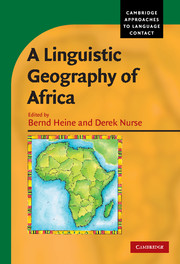Book contents
- Frontmatter
- Contents
- List of maps
- List of figures
- List of tables
- List of contributors
- Series editor's foreword
- Acknowledgments
- Abbreviations
- 1 Introduction
- 2 Is Africa a linguistic area?
- 3 Africa as a phonological area
- 4 Africa as a morphosyntactic area
- 5 The Macro-Sudan belt: towards identifying a linguistic area in northern sub-Saharan Africa
- 6 The Tanzanian Rift Valley area
- 7 Ethiopia
- 8 The marked-nominative languages of eastern Africa
- 9 Africa's verb-final languages
- Notes
- References
- Index
Series editor's foreword
Published online by Cambridge University Press: 22 September 2009
- Frontmatter
- Contents
- List of maps
- List of figures
- List of tables
- List of contributors
- Series editor's foreword
- Acknowledgments
- Abbreviations
- 1 Introduction
- 2 Is Africa a linguistic area?
- 3 Africa as a phonological area
- 4 Africa as a morphosyntactic area
- 5 The Macro-Sudan belt: towards identifying a linguistic area in northern sub-Saharan Africa
- 6 The Tanzanian Rift Valley area
- 7 Ethiopia
- 8 The marked-nominative languages of eastern Africa
- 9 Africa's verb-final languages
- Notes
- References
- Index
Summary
The series Cambridge Approaches to Language Contact (CALC) was set up to publish outstanding monographs on language contact, especially by authors who approach their specific subject matter from a diachronic or developmental perspective. Our goal is to integrate the ever-growing scholarship on language diversification (including the development of creoles, pidgins, and indigenized varieties of colonial European languages), bilingual language development, code-switching, and language endangerment. We hope to provide a select forum to scholars who contribute insightfully to understanding language evolution from an interdisciplinary perspective. We favor approaches that highlight the role of ecology and draw inspiration both from the authors' own fields of specialization and from related research areas in linguistics or other disciplines. Eclecticism is one of our mottoes, as we endeavor to comprehend the complexity of evolutionary processes associated with contact.
A Linguistic Geography of Africa diverges from the above tradition only in not being a monograph. We have made this exception because of the rich addition that the volume makes to the scholarly goals of CALC. Bernd Heine and Derek Nurse enrich the series with an outstanding collection of contributions that make evident how the linguistic history of a vast territory is naturally complicated by an intricate entanglement of genetic and areal ties. The backbone of the book consists of a few fundamental questions, including the following: why are the genetic and typological classifications of African languages not coextensive? Why are there so many typological features that cut across well-established genetic classifications of languages? How significant is the role of areal diffusion, therefore of language contact, in the structural affinities observable among so many languages?
- Type
- Chapter
- Information
- A Linguistic Geography of Africa , pp. xii - xiiiPublisher: Cambridge University PressPrint publication year: 2007



